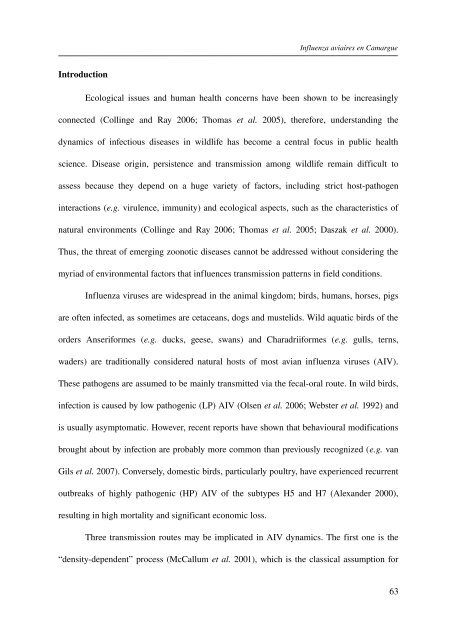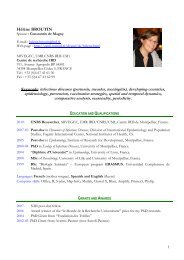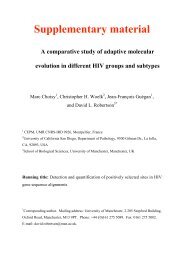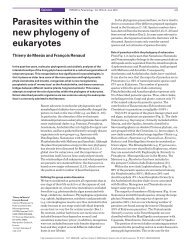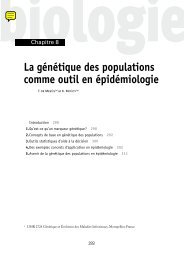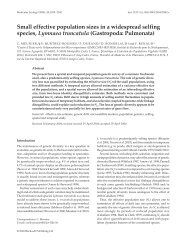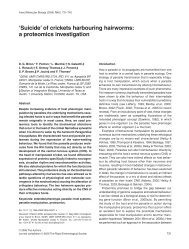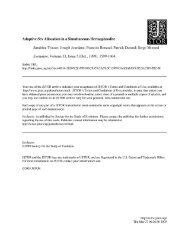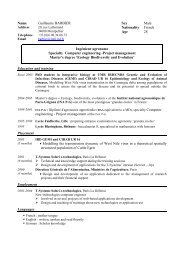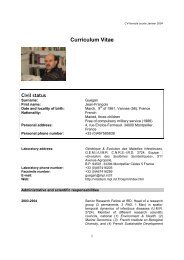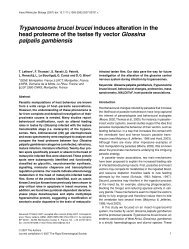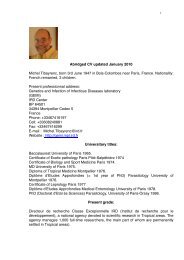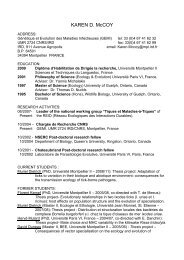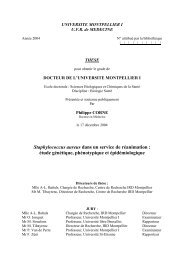écologie des virus influenza aviaires en Camargue - IRD
écologie des virus influenza aviaires en Camargue - IRD
écologie des virus influenza aviaires en Camargue - IRD
You also want an ePaper? Increase the reach of your titles
YUMPU automatically turns print PDFs into web optimized ePapers that Google loves.
Influ<strong>en</strong>za <strong>aviaires</strong> <strong>en</strong> <strong>Camargue</strong>IntroductionEcological issues and human health concerns have be<strong>en</strong> shown to be increasinglyconnected (Collinge and Ray 2006; Thomas et al. 2005), therefore, understanding thedynamics of infectious diseases in wildlife has become a c<strong>en</strong>tral focus in public healthsci<strong>en</strong>ce. Disease origin, persist<strong>en</strong>ce and transmission among wildlife remain difficult toassess because they dep<strong>en</strong>d on a huge variety of factors, including strict hostpathog<strong>en</strong>interactions (e.g. virul<strong>en</strong>ce, immunity) and ecological aspects, such as the characteristics ofnatural <strong>en</strong>vironm<strong>en</strong>ts (Collinge and Ray 2006; Thomas et al. 2005; Daszak et al. 2000).Thus, the threat of emerging zoonotic diseases cannot be addressed without considering themyriad of <strong>en</strong>vironm<strong>en</strong>tal factors that influ<strong>en</strong>ces transmission patterns in field conditions.Influ<strong>en</strong>za <strong>virus</strong>es are wi<strong>des</strong>pread in the animal kingdom; birds, humans, horses, pigsare oft<strong>en</strong> infected, as sometimes are cetaceans, dogs and mustelids. Wild aquatic birds of theorders Anseriformes (e.g. ducks, geese, swans) and Charadriiformes (e.g. gulls, terns,waders) are traditionally considered natural hosts of most avian <strong>influ<strong>en</strong>za</strong> <strong>virus</strong>es (AIV).These pathog<strong>en</strong>s are assumed to be mainly transmitted via the fecaloral route. In wild birds,infection is caused by low pathog<strong>en</strong>ic (LP) AIV (Ols<strong>en</strong> et al. 2006; Webster et al. 1992) andis usually asymptomatic. However, rec<strong>en</strong>t reports have shown that behavioural modificationsbrought about by infection are probably more common than previously recognized (e.g. vanGils et al. 2007). Conversely, domestic birds, particularly poultry, have experi<strong>en</strong>ced recurr<strong>en</strong>toutbreaks of highly pathog<strong>en</strong>ic (HP) AIV of the subtypes H5 and H7 (Alexander 2000),resulting in high mortality and significant economic loss.Three transmission routes may be implicated in AIV dynamics. The first one is the“d<strong>en</strong>sitydep<strong>en</strong>d<strong>en</strong>t” process (McCallum et al. 2001), which is the classical assumption for63


